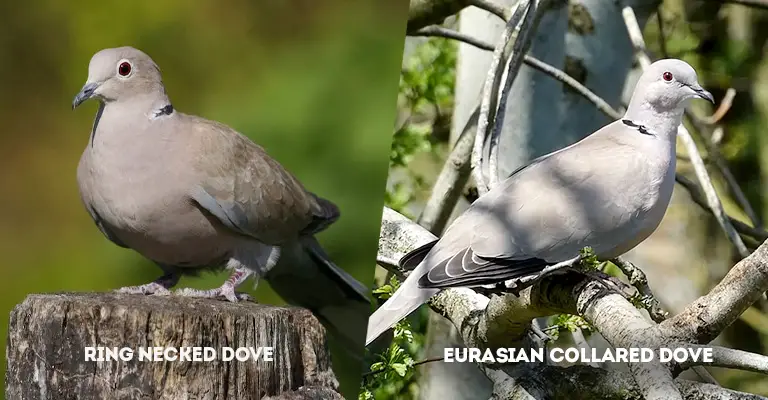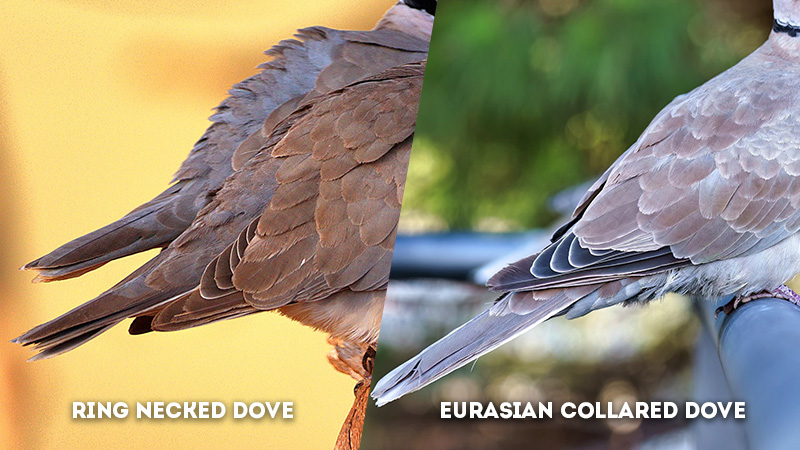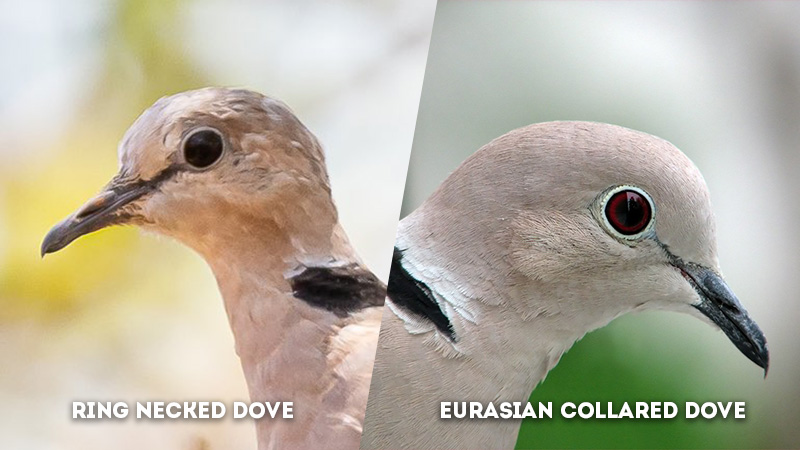Ring-necked Doves and Eurasian Collared Doves are avian species that grace diverse landscapes across continents, each with distinctive characteristics that set them apart.
These doves, Streptopelia capicola and Streptopelia decaocto respectively, captivate observers with their melodious calls, distinct plumage, and adaptable behaviors.
As denizens of varied habitats, their interactions with their environments and roles within ecosystems intrigue bird enthusiasts and researchers alike.
Exploring the differences between these doves, from their feeding habits to their conservation statuses, sheds light on their ecological significance and the intriguing ways they have responded to changing landscapes shaped by human and natural factors.

Key Differences Between Ring-necked Dove and Eurasian Collared Dove
Ring-necked Dove (Streptopelia capicola) and Eurasian Collared Dove (Streptopelia decaocto) are two distinct species of doves with some notable differences:
Scientific Name
- Ring-necked Dove: The Ring-necked Dove, scientifically known as Streptopelia capicola, is a bird species predominantly found in Africa. It is distinguishable from the Eurasian Collared Dove by several key features.
- Eurasian Collared Dove: The Eurasian Collared Dove, scientifically referred to as Streptopelia decaocto, is a species native to Europe, Asia, and parts of North America. It exhibits distinct characteristics that set it apart from the Ring-necked Dove.
Geographic Distribution
- Ring-necked Dove: The Ring-necked Dove, scientifically known as Streptopelia capicola, is primarily distributed across the African continent.
This species is commonly found in various African countries, thriving in a range of habitats from open woodlands to urban areas. Its geographic range spans from northern Africa to southern Africa, and it has adapted well to the diverse environments within the continent. - Eurasian Collared Dove: The Eurasian Collared Dove, identified by its scientific name Streptopelia decaocto, has a notably different distribution pattern.
This species originates from Europe and Asia but has also successfully established populations in parts of North America.
Introduced to North America in the 1980s, the Eurasian Collared Dove has rapidly expanded its range and can now be found in urban, suburban, and rural environments across the continent.
Tail Feather Coloration

- Ring-necked Dove: The Ring-necked Dove is characterized by pale bases on its tail feathers. These pale areas are prominent and contribute to the bird’s distinctive appearance when in flight or perched. The contrast between the pale bases and the rest of the tail feathers is a key visual feature.
- Eurasian Collared Dove: In contrast, the Eurasian Collared Dove showcases tail feathers with darker gray coloration. This characteristic sets it apart from the Ring-necked Dove and provides a visual clue for distinguishing the two species at a glance.
Crown Feather Coloration
- Ring-necked Dove: The Ring-necked Dove exhibits a gray crown, which is the area of feathers on the top of its head. These gray crown feathers add to the bird’s overall coloration and contribute to its appearance.
- Eurasian Collared Dove: On the other hand, the Eurasian Collared Dove displays light gray crown feathers.
This shade of gray, coupled with other distinguishing features, helps birdwatchers and enthusiasts identify this species separately from the Ring-necked Dove.
Call
- Ring-necked Dove: The vocalizations of the Ring-necked Dove, scientifically known as Streptopelia capicola, serve as a distinct characteristic that sets it apart from the Eurasian Collared Dove.
Its call is a series of soft, rhythmic coos that are often delivered in a pattern, creating a soothing and melodic sound. - Eurasian Collared Dove: The Eurasian Collared Dove, identified by its scientific name Streptopelia decaocto, possesses a different type of cooing call that distinguishes it from the Ring-necked Dove.
Its call is also a series of coos, but it tends to be slightly more variable and can include variations in pitch and rhythm.
Size
- Ring-necked Dove: In terms of size, the Ring-necked Dove is slightly smaller compared to the Eurasian Collared Dove.
This size difference might not always be immediately noticeable in the field, but upon closer observation, the Ring-necked Dove tends to have a more delicate and compact appearance. - Eurasian Collared Dove: The Eurasian Collared Dove, on the other hand, is slightly larger than the Ring-necked Dove.
This difference in size is often more noticeable when comparing the two species side by side. The Eurasian Collared Dove’s larger size contributes to its overall robust appearance.
Range of Habitat
- Ring-necked Dove: The Ring-necked Dove’s habitat preferences are versatile, ranging from open woodlands to urban areas.
This species can be found across various regions within Africa, adapting well to a range of environments that include savannas, gardens, agricultural fields, and even city parks. - Eurasian Collared Dove: The Eurasian Collared Dove’s habitat range is broader, extending from its native Europe and Asia to parts of North America.
This species is often associated with human settlements and urban areas, where it has become a familiar sight in suburban neighborhoods, farmlands, and cities.
Plumage
- Ring-necked Dove: The plumage of the Ring-necked Dove features subtle brown and gray tones, creating a soft and earthy appearance.
This muted coloration provides effective camouflage in its natural habitats and contributes to its unobtrusive presence. - Eurasian Collared Dove: The Eurasian Collared Dove boasts a distinct plumage characterized by light gray feathers with pinkish undertones.
This coloring is particularly noticeable on the bird’s chest and undertail coverts. The presence of pinkish hues adds vibrancy to its appearance and sets it apart from the Ring-necked Dove’s more subdued coloration.
Eye Ring Color

- Ring-necked Dove: The Ring-necked Dove lacks a distinct eye ring, with its eye surrounded by feathers that match the rest of its plumage.
This absence of an eye ring is one of the visual cues that differentiates it from the Eurasian Collared Dove. - Eurasian Collared Dove: The Eurasian Collared Dove is recognized by its thin white eye-ring. This eye ring creates a defining feature around its eyes, offering a point of contrast against its light gray plumage.
Breeding Behavior
- Ring-necked Dove: The breeding behavior of the Ring-necked Dove, scientifically known as Streptopelia capicola, is characterized by monogamous nesting pairs.
These doves engage in courtship rituals that involve cooing displays, where the male and female interact through soft calls and posturing. Once a pair forms, they build a strong bond that persists through the breeding season. - Eurasian Collared Dove: The Eurasian Collared Dove, identified as Streptopelia decaocto, exhibits a different breeding behavior. While it can also form monogamous pairs, it is notable for its social nesting tendencies.
Unlike the Ring-necked Dove, the Eurasian Collared Dove is often seen nesting in colonies, with multiple pairs establishing their nests in close proximity to one another.
Nesting Locations
- Ring-necked Dove: The Ring-necked Dove selects a range of nesting locations, including trees, shrubs, and ledges.
They often choose elevated sites for their nests, where they can have a clear view of their surroundings. This choice of nesting location provides protection against ground-based predators. - Eurasian Collared Dove: The Eurasian Collared Dove is known for its adaptability to urban environments. It commonly nests in trees, but it has also adapted to nesting on buildings, utility poles, and other man-made structures. This behavior contributes to its success in urban and suburban areas.
Nesting Materials
- Ring-necked Dove: Ring-necked Doves construct their nests using a combination of sticks, twigs, and grass. The nest is a relatively simple structure, often placed in the fork of a tree branch or a secure ledge. These materials provide a sturdy base for the eggs and young.
- Eurasian Collared Dove: Similar to the Ring-necked Dove, the Eurasian Collared Dove also employs sticks and twigs as primary nesting materials.
However, the nests of the Eurasian Collared Dove are often described as more flimsy compared to those of the Ring-necked Dove. This might be attributed to the species’ adaptability to nesting in a wider range of environments.
Eggs
- Ring-necked Dove: The Ring-necked Dove typically lays white eggs. The number of eggs per clutch can vary, but it often consists of two eggs. The eggs are relatively small and oval-shaped.
- Eurasian Collared Dove: The Eurasian Collared Dove also lays white eggs, usually numbering two per clutch. These eggs are slightly larger than those of the Ring-necked Dove, reflecting the species’ larger size.
Incubation Period
- Ring-necked Dove: The incubation period for Ring-necked Dove eggs is approximately 14 days. During this time, the female incubates the eggs, keeping them warm and protected.
- Eurasian Collared Dove: The Eurasian Collared Dove’s incubation period is slightly longer, lasting about 14 to 18 days. This variation in incubation time might be linked to factors such as climate and environmental conditions.
Fledgling Appearance
- Ring-necked Dove: The fledgling Ring-necked Dove is covered in downy feathers that are gray in color. These downy feathers provide insulation and protection for the young bird as it begins to explore its surroundings.
- Eurasian Collared Dove: The fledgling Eurasian Collared Dove also displays downy feathers. However, its downy feathers are light gray in color. This coloring aligns with the species’ overall plumage.
Feeding Habits
- Ring-necked Dove: The Ring-necked Dove, scientifically known as Streptopelia capicola, primarily feeds on seeds and grains.
It has a particular affinity for foraging on the ground, using its bill to pick up and consume these plant-based food sources. Additionally, it occasionally supplements its diet with insects and other small invertebrates. - Eurasian Collared Dove: The Eurasian Collared Dove, identified as Streptopelia decaocto, shares a similar feeding habit of consuming seeds and grains.
However, it shows a preference for feeding on the ground in open areas, often scavenging for fallen seeds and grains.
Invasive Species Impact (if Applicable)
- Ring-necked Dove: The Ring-necked Dove is not considered an invasive species in any regions where it is naturally found. It coexists with other native bird species and plays its role within the local ecosystems without causing significant disruption.
- Eurasian Collared Dove: The Eurasian Collared Dove has gained a reputation as an invasive species in some regions, particularly in North America.
Its introduction to the continent has led to concerns about its impact on native bird species and competition for resources. Despite this, it has also found ecological niches in urban environments and managed to coexist with native species.
Introduction to Other Regions
- Ring-necked Dove: The Ring-necked Dove is native to Africa and has not been intentionally introduced to other regions as far as scientific records show. Its natural distribution across the African continent remains its primary habitat.
- Eurasian Collared Dove: The Eurasian Collared Dove, originally native to Europe and Asia, was intentionally introduced to North America.
It first arrived in the Bahamas in the 1970s and subsequently spread to the United States and Canada. This intentional introduction has led to a broader distribution of the species.
Migratory Behavior (if Applicable)
- Ring-necked Dove: The Ring-necked Dove is generally considered non-migratory. It tends to maintain a relatively stable territory throughout the year, with individuals often residing in the same area as long as suitable resources are available.
- Eurasian Collared Dove: The Eurasian Collared Dove’s migratory behavior is more complex. While the species is largely sedentary in its native range, some populations have shown migratory tendencies in response to seasonal changes and resource availability.
In regions with harsh winters, some individuals might migrate to more temperate areas to ensure access to food.
Conservation Status
- Ring-necked Dove: The conservation status of the Ring-necked Dove is classified as “Least Concern” by the International Union for Conservation of Nature (IUCN).
This status indicates that the species is not facing immediate threats on a global scale and is considered relatively stable in its native range. - Eurasian Collared Dove: The Eurasian Collared Dove is also listed as “Least Concern” by the IUCN.
Despite its invasive status in some areas, its adaptable nature and ability to thrive in various environments have contributed to its stable populations and overall conservation status.
Ring Necked Dove vs. Eurasian Collared Dove: Comparison Table
| Feature | Ring-necked Dove | Eurasian Collared Dove |
|---|---|---|
| Scientific Name | Streptopelia capicola | Streptopelia decaocto |
| Geographic Distribution | Primarily Africa | Eurasia, North America |
| Tail Feather Coloration | Pale bases | Darker gray |
| Crown Feather Coloration | Grey | Light gray |
| Call | Distinctive cooing call | Cooing call with variation |
| Size | Slightly smaller | Slightly larger |
| Range of Habitat | Varied, including urban areas | Urban areas and open habitats |
| Plumage | Subtle brown and gray tones | Light gray with pinkish undertones |
| Eye Ring Color | Absent | Thin white eye ring |
| Breeding Behavior | Monogamous nesting pairs | Social, can nest in colonies |
| Nesting Locations | Trees, shrubs, and ledges | Trees, buildings, utility poles |
| Nesting Materials | Sticks, twigs, grass | Similar materials, often flimsy |
| Eggs | White eggs | White eggs, usually two |
| Incubation Period | Around 14 days | About 14-18 days |
| Fledgling Appearance | Downy, gray | Downy, light gray |
| Feeding Habits | Seeds, grains, some insects | Seeds, grains, occasional insects |
| Invasive Species Impact (if applicable) | Not invasive | Invasive in some regions |
| Introduction to Other Regions | Native to its range | Introduced to new regions |
| Migratory Behavior (if applicable) | Generally non-migratory | Can show migratory tendencies |
| Conservation Status | Least Concern (IUCN) | Least Concern (IUCN) |
Frequently Asked Questions
Yes, Ring-necked Doves are known for their habit of sunbathing, where they spread their wings and expose their bodies to the sun. This behavior is thought to help regulate their body temperature and manage feather mites. Eurasian Collared Doves, on the other hand, are known for their distinctive courtship flights, during which they fly in an upward spiral while making cooing calls to attract a mate.
Both species exhibit territorial behavior during breeding seasons. Ring-necked Doves establish territories through vocalizations and displays to defend their nesting sites. Eurasian Collared Doves also engage in territorial behavior, using their cooing calls and aerial displays to communicate and establish their presence.
Ring-necked Doves play a role in seed dispersal as they consume and then spread seeds through their droppings. They also provide a food source for predators and scavengers. Eurasian Collared Doves can impact local ecosystems by competing with native bird species for resources and nesting sites.
Yes, in various cultures, doves are often associated with symbols of peace and love due to their gentle and cooing nature. In some societies, doves are considered as messengers or symbols of divine presence. The cooing calls of these doves have also been featured in literature, music, and art across different regions.
Human activities, such as urbanization and habitat modification, have provided both species with new opportunities. Urban environments offer a consistent food supply and nesting sites, which has contributed to their success. However, these changes also bring challenges like collisions with buildings and reliance on human-provided food, which can affect their natural behaviors and health.
To Recap
In the realm of avian diversity, the Ring-necked Dove and Eurasian Collared Dove stand as captivating representatives of their respective regions. Their unique calls, behaviors, and physical traits offer a glimpse into the intricate tapestry of nature’s adaptations.
As these doves coexist with human-altered environments and shape ecosystems, their stories underscore the dynamic relationship between wildlife and civilization.
From African woodlands to North American suburbs, their journeys highlight the remarkable resilience of these feathered companions in the face of ever-changing landscapes.